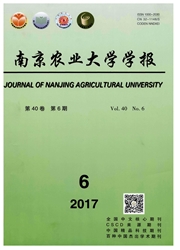

 中文摘要:
中文摘要:
通过对黄瓜种间杂交后代BC1F4群体进行农艺学和细胞学分析,鉴定筛选出抗枯萎病异源易位植株AT-04。农艺学观察表明,其具有小叶、短果、棕色瘤刺、多分枝的特点,形态上偏向原始亲本野生种Cucumis hystrix Chakr.,育性与栽培黄瓜相近。细胞学研究发现,AT-04在有丝分裂的中后期至少有1对染色体的姊妹染色单体分离明显滞后。在减数分裂终变期,平均每个花粉母细胞有0.2个四价体、0.05个六价体和0.05个八价体,约30%的花粉母细胞中存在拉十字的染色体。在中期Ⅰ,7个二价体出现分组分布现象,主要以3+2+2形式存在,表明其至少经历了4次染色体易位。田间调查和人工接种鉴定均表明,易位植株AT-04及其自交后代和野生种C.hystrix对枯萎病具有较高抗性。
 英文摘要:
英文摘要:
Agronomic and cytological methods were combined in identification and characterization of an alien translocation plant (AT-04) among plants of population BCI F4 that was derived from the interspecific hybridizs, tion between Cucumis savitus L. and C. hystrix Chakr.. In morphology, the plant AT-04 was characterized to have small-sized leaf, short fruit, brown spine and multi-branching habit, which were closely similar to those of the original parent wild species ( C. hystrix), and to have a fertility as high as that of cultivated cucumber. Cytological observation in AT-04 showed that sister chromatids in at least one pair of somatic chromosomes were delayed obviously in separation at late metaphase. At diakinesis, 0. 2, tetravalents, 0. 05 hexavalents and 0. 05 octovalents per pollen mother cell (PMC) were detected, which was absent in cuhivated cucumber. In 30% PMCs, crossed chromosomes occurred at diakinesis. At metaphase Ⅰ , 7 bivalents were frequently detected to separate into three groups, with a form of 3+2+2, which indicated that at least four translocation events once occurred. Results from both field investigation on plants and artificial inoculation on seedlings of AT-04 and its progenies from selfing confirmed their resistance to fusarium wilt as observed in the wild species C. hystrix.
 同期刊论文项目
同期刊论文项目
 同项目期刊论文
同项目期刊论文
 期刊信息
期刊信息
